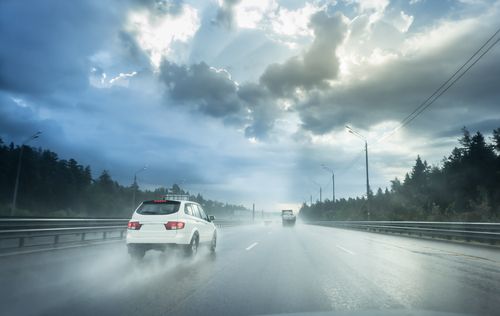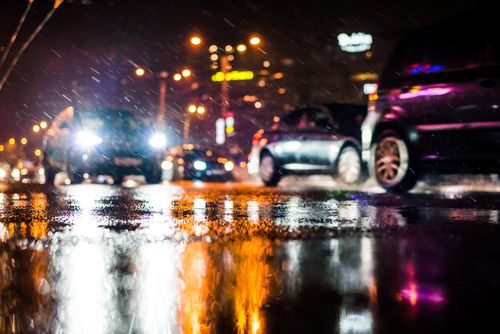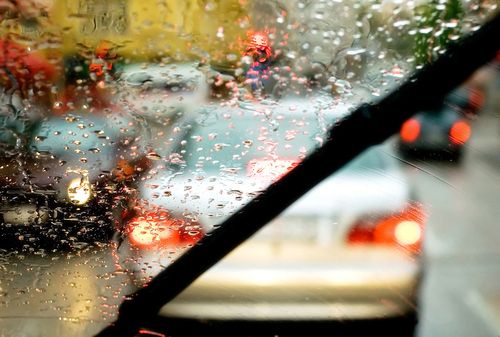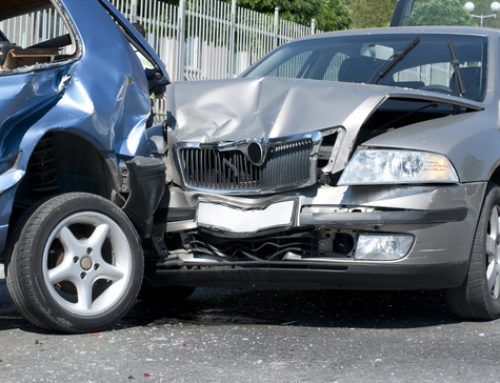Here in the Baltimore area, we typically get more than 40 inches of rain each year. This means that you’ll frequently have to drive in the rain throughout the year. During times of inclement weather, there are far more automobile accidents than on sunny days, and much of this is due to the fact that many people don’t know how to properly drive in the rain. Follow these tips to keep yourself and your passengers as safe as possible while driving in the rain.
1. Slow Down
When it rains, the roads will be slicker than usual, making it more difficult for your tires to get good traction with the road. At high speeds, typically over 55 miles per hour, you run the risk of hydroplaning. When this happens, your tires lose traction with the road, and your car feels as though it is floating on top of the water.
If this happens to you, it can be incredibly scary, but it is crucial that you remain calm. Keep a firm grip on the steering wheel to hold it steady, and take your foot off the gas pedal to slow down. Resist the urge to hit the brakes, as this can cause you to lose control. Once your tires regain traction, keep your speed at that level or lower.
2. Increase Your Following Distance
If you have to hit the brakes suddenly, the slippery road conditions can cause you to skid, so you want to try to avoid hard braking whenever possible. Increase your following distance from the car in front of you. When driving in the rain, you should have a 4- to 5-second following distance.
To calculate your following distance, choose a marker on the road ahead of you, like a light pole or lane line segment. When the car in front of you passes that point, start counting. Stop counting when you reach that same point. The number of seconds that have passed is your following distance. The longer your following distance, the more time you’ll have to react to changing road conditions in front of you.
3. Accelerate and Decelerate Smoothly
When the roads are slick, you don’t want to floor the gas pedal or slam on the brakes, as those actions can increase your risk of skidding. Accelerate and decelerate gradually instead to help your tires keep traction on the road. Although it may take you slightly longer to get up to cruising speed, the few extra seconds are well worth it in terms of preserving your safety.
4. Take Turns More Slowly
Any time you make a turn in your vehicle, it puts added pressure on the outer edges of your tires to maintain traction with the road. If you enter a turn too quickly, your tires won’t be able to get the grip they need to make your car turn. Instead, you may skid a bit, even sliding across a few lanes at high speeds.
To stay safe, slow down a bit more as you enter the turn, and release the brakes when you start turning the steering wheel, coasting through the turn. Once you have straightened the steering wheel again, it is safe to accelerate.
5. Take Extra Care in the First Few Minutes of Rain
The first few minutes after the rain starts to fall are the most dangerous. This is because oil and other substances drip out of vehicles as they drive. Over time, this oil builds up on the roads. When the rain first starts, it combines with the oil to make the roads at their slickest. After a while, the rain will wash away much of the oil, reducing the risk.
If you are getting ready to leave your house and it has just started raining, wait a few more minutes before heading out if possible. This way, the worst of it will be over by the time you hit the road. If you still feel that the road conditions are unsafe, feel free to pull over in a safe area to wait a few more minutes.
6. Minimize Distractions
Because driving in the rain can be so risky, you want to make sure you have your wits about you. Put away your phone, turn down the music and focus on the task at hand. Road conditions can change in a split second, and you want to have as much time to react as possible to prevent having to engage in risky behavior, like sudden braking or swerving.
7. Turn On Your Headlights
Even if it is the middle of the day, you should always turn your headlights on when it is raining. On rainy days, visibility is much lower than it usually is, and you want other drivers to be able to see you coming. If your car has automatic headlights, they will likely activate on their own, but if you don’t have this feature, you’ll need to do it manually.
8. Use Your Turn Signals
Be sure to take other drivers into consideration as well. They may be so focused on their own driving that they don’t realize what you are doing. Always use your turn signals in the rain, even if you don’t think there are any other cars nearby. There may be a car in your blind spot that you haven’t noticed, and you want to ensure that they know what to expect from you, even if you don’t see them.
9. Don’t Make Sudden Moves
This is a bit of an extension of the previous tip for driving in the rain. Whenever you need to change lanes, take your time to allow other drivers to accommodate you. Once you have activated your turn signal, wait a few seconds before making your move, and always check your blind spot before entering another lane.
10. Anticipate the Actions of Other Drivers
Just as you want other drivers to know what you are doing, you need to pay attention to what other drivers are doing as well. Keep in mind that not everyone is a safe driver, especially in the rain, so you may find that other drivers don’t follow the guidelines outlined here. Try to think about what the person in front of you is likely to do next, including the drivers in adjacent lanes. You want to be ready in case someone decides to change lanes or hit the brakes suddenly.
In addition to the car immediately in front of you, try to look a few cars ahead whenever possible as well. This way, you’ll be able to see if others are slowing down up ahead, even if the car in front of you hasn’t started to slow down yet. The more aware you are of your surroundings, the better you will be able to react to any unexpected occurrences.
11. Familiarize Yourself with Your Route
Before you leave your home, make sure that you know where you are going, especially if you are heading to a new destination. Because visibility is lower on rainy days, you won’t be able to see the street signs as clearly, especially from a distance. You don’t want to have to keep checking the directions while on the road, and you don’t want to have to make last-minute lane changes or turns.
Try to remember the approximate distance between each turn so that you know when to expect the street to come up. Get into the appropriate lane to make the turn well in advance to avoid making any sudden moves that could endanger you and other drivers.
12. Use Your Windshield Wipers
This may seem like a no-brainer, but it’s amazing how many people neglect to use their windshield wipers in the rain. In some cases, they may believe that the rain is light enough that they don’t need them, or it could be that the blades need to be replaced.
Before heading into the rainy season, take the time to replace your wiper blades. For most vehicles, this is not expensive, and the difference is night and day in terms of visibility, especially when it is raining heavily.
13. Make Sure Your Car Is in Good Repair
Aside from your wiper blades, you want to ensure that the rest of your car is in good condition as well. This is particularly important for your tires, as they help your car grip the road properly. Check that your tires are not too worn down, and replace them if needed. If the treads on your tires look good, make sure that they are properly inflated so that they can work properly.
Keep up with other general maintenance on your vehicle as well, like your brakes, power steering, engine oil, transmission and more. Refer to your owner’s manual, or consult your dealership or private mechanic to ensure that everything in your car is working as it should.
14. Keep Your Insurance and Roadside Assistance Up to Date
Of course, you should always have valid car insurance, as it is required by law in order to maintain a driver’s license in the state of Maryland, but insurance is even more important in times of bad weather. Because the risk of getting into an accident is so much higher, you want to have confidence that you are protected in case anything goes wrong. If your policy doesn’t already include coverage for uninsured motorists, you may wish to consider adding this feature. This way, you are still protected, even if you are hit by someone who doesn’t have insurance.
In addition to insurance, you should also make sure that you have active roadside assistance coverage in case of emergencies. In some cases, this may be included in your insurance policy or be an option to add on. If your insurance company doesn’t offer this service, you may wish to purchase it from another organization, like AAA. If you get a flat tire, run out of gas, break down or experience other complications while out on the road, your roadside assistance company will dispatch a technician to your location to address the problem or tow your car to a repair shop. This service can come in handy in sunny conditions as well, so you should maintain this service all year long.
15. Know What to Do in an Accident
Because car accidents are far more likely in poor weather conditions, you want to be prepared in case it happens to you. Regardless of whether the accident is your fault, you and the other driver need to exchange information. This includes driver’s licenses, insurance information, vehicle registrations and contact details. You should also take photos of both of your vehicles to record the damage, no matter how minor.
If the accident is minor, like a fender-bender, pull your vehicle over to the side of the road or into a parking lot to get out of the flow of traffic. If the accident was more severe, though, don’t attempt to move the vehicles, as police will likely want to record their locations. Check with everyone involved to ensure no one is severely injured.
If you have been injured in an auto accident, you should seek medical attention right away. Keep in mind that symptoms may not appear until a few days after the accident, so it is always best to err on the side of caution. Report the incident to your insurance company immediately. Your insurance agent can advise you on any next steps you need to take.
You may also wish to enlist the services of an attorney with experience in auto accidents. This can help you get compensated fairly if the other driver does not have insurance or denies that they were at fault. Here at Ingerman & Horwitz, we have helped thousands of motorists in the Baltimore area with their auto accident cases, and we can help you too. Get in touch with us today to schedule a free consultation with one of our attorneys.
















